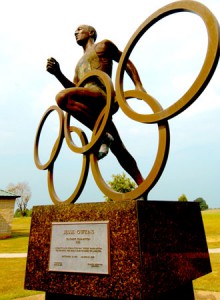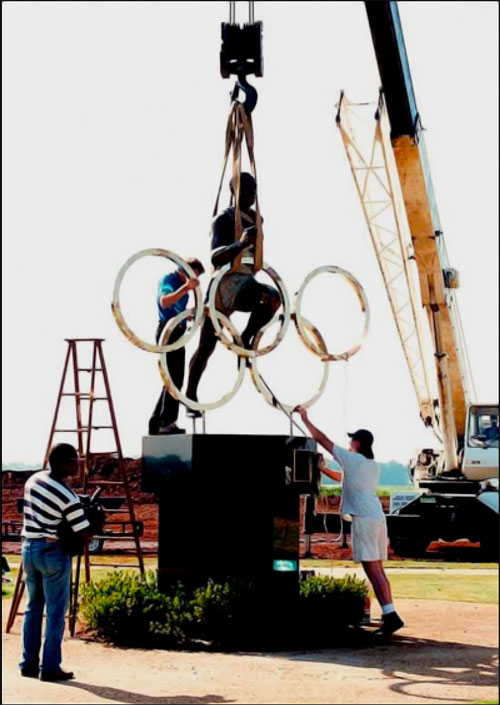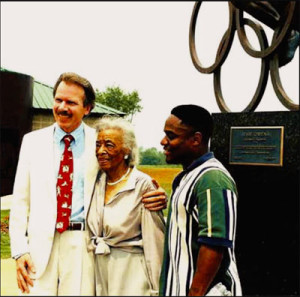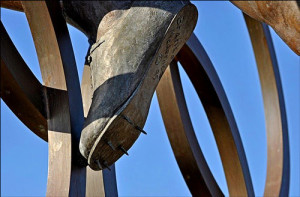
Jesse Owens Memorial Park and Museum Statue that was unveiled with the help of Ruth Owens in Oakville, Alabama.
The bronze statue stands strikingly at the top of the hill on the 30-acre park in Oakville, Alabama. The place that Jesse once called home.
Branko Medenica was commissioned by the Jesse Owens Memorial Park Board to create the sculpture. For Medenica, sculpting the statue of the Olympic great was a labor of love. Before undertaking the project, he met with the Owens family in Chicago to get personal details about Owens. “I wanted to know what he was like psychologically – what kind of person he was,” Medenica said. “For some artists, that is not important, but to me it was. It helped me bring forth the idea of what Jesse Owens was all about.”
Owens’ daughter, Marlene Owens Rankin said she was glad he cared so much about getting a complete picture of her father. “We all think it’s great. He was concerned about it being a true representation of the person.”
Medenica decided there was a strong message to illustrate through his art, “The Olympic rings were like a finish line,” he said. “They represented a barrier. Owens broke so many barriers.” The design he envisioned depicted Owens bursting through the Olympic rings to represent all the racial and economic barriers that he broke in becoming an Olympic hero.

(L-R) Marlene Owens Rankin, Beverly Owens Prather and Gloria Owens Hemphill in front of the statue at the park.
However, the vision of Medenica’s statue and its message, led to a two-year battle with the U.S. Olympic Committee. Citing copyright laws, they told Medenica he could not use the Olympic rings. But determined, he relentlessly called and wrote the committee and even sought the help of Owens’ daughter, Marlene Owens Rankin. Mrs. Rankin supported Medenica and encouraged the Olympic Committee to approve the use of the rings.
Ultimately – exactly two years to the date of his first letter, the Olympic Committee gave him permission to use the rings. Medenica had to finish his three-year project in around four months. The sculpture was scheduled to be unveiled at a highly publicized ceremony on June 29, which included Owens’ wife and daughters as well as the arrival the Olympic torch.
With only two days before the official ceremony, the sculpture was being anchored on its base.

Statue being permanently anchored on its base within only a few days ahead of the Olympic torch arrival.
Medenica’s race to finish the statue and insure it was a fitting tribute was accomplished. With all its amazing and intricate detail – down to the cleats on Owens’ running shoes, the eight-foot, one-ton bronze work of art was unveiled, as scheduled, on June 29, 1996 with the help of Ruth Owens. Upon seeing the statue she said, “I’ve seen a lot of statues of Jesse, but his one is the best. It looks just like him.”

Branko Medenica (sculptor) and Ruth Owens after the statue dedication at the Jesse Owens Memorial Park and Museum.
Medenica was born in Germany, the country where the black track star captured four gold medals at the 1936 Olympics. He moved to Huntsville when his father, a NASA engineer, became part of the man-on-the-moon team. Now a resident of Birmingham, Alabama Medenica states, “One German helped Jesse Owens during the Olympics. Another German is helping to immortalize him.”

A close up of the intricate detail – down to the cleats on Owens’ running shoes, on the eight-foot, one-ton bronze work of art designed by Branko Medenica.


